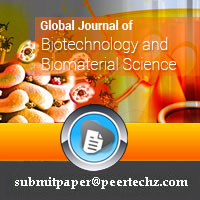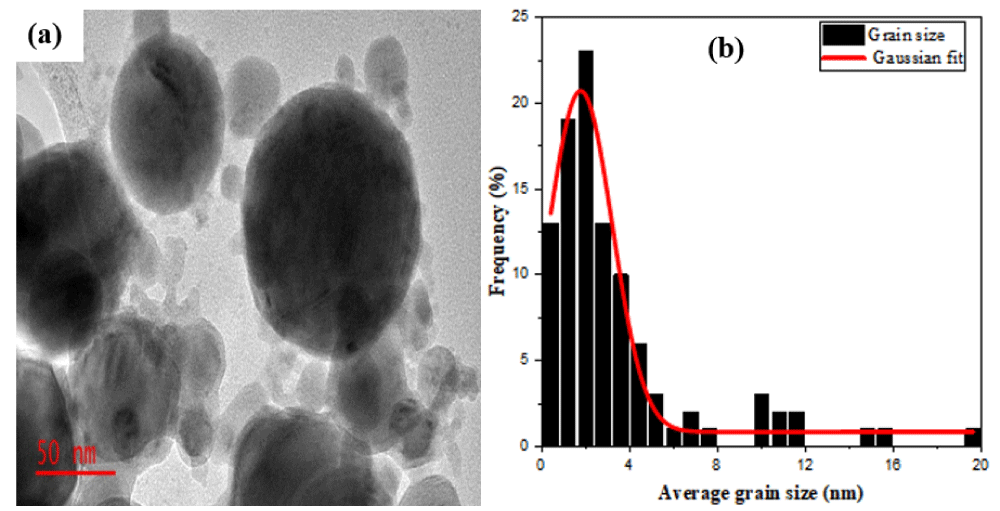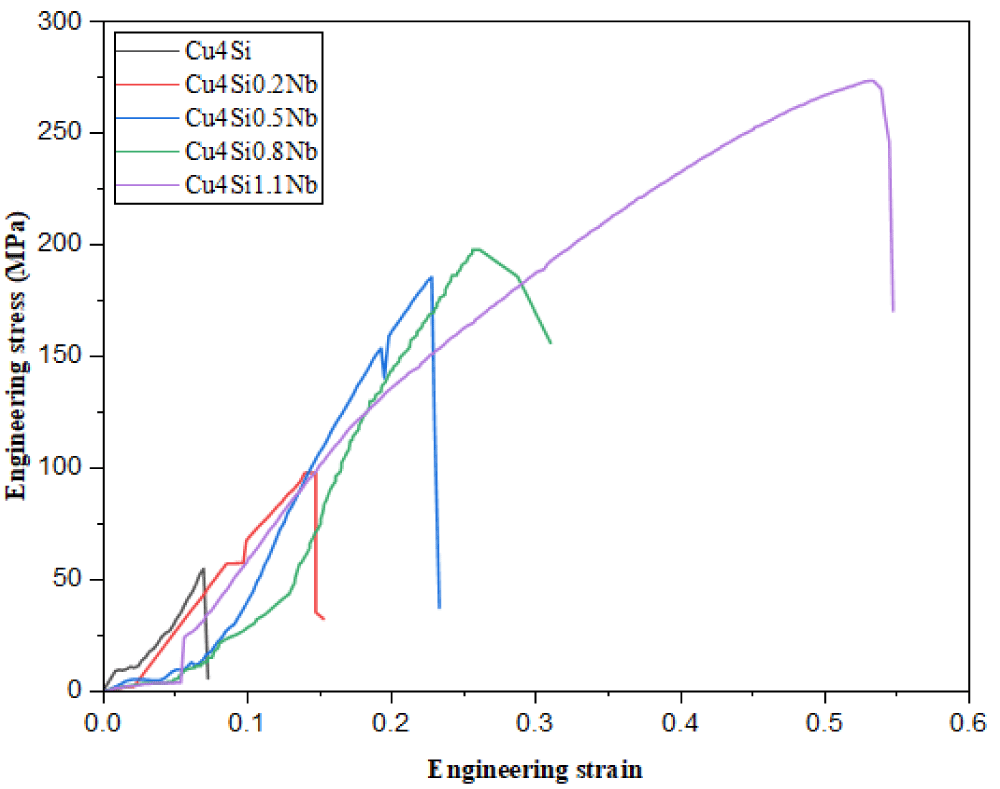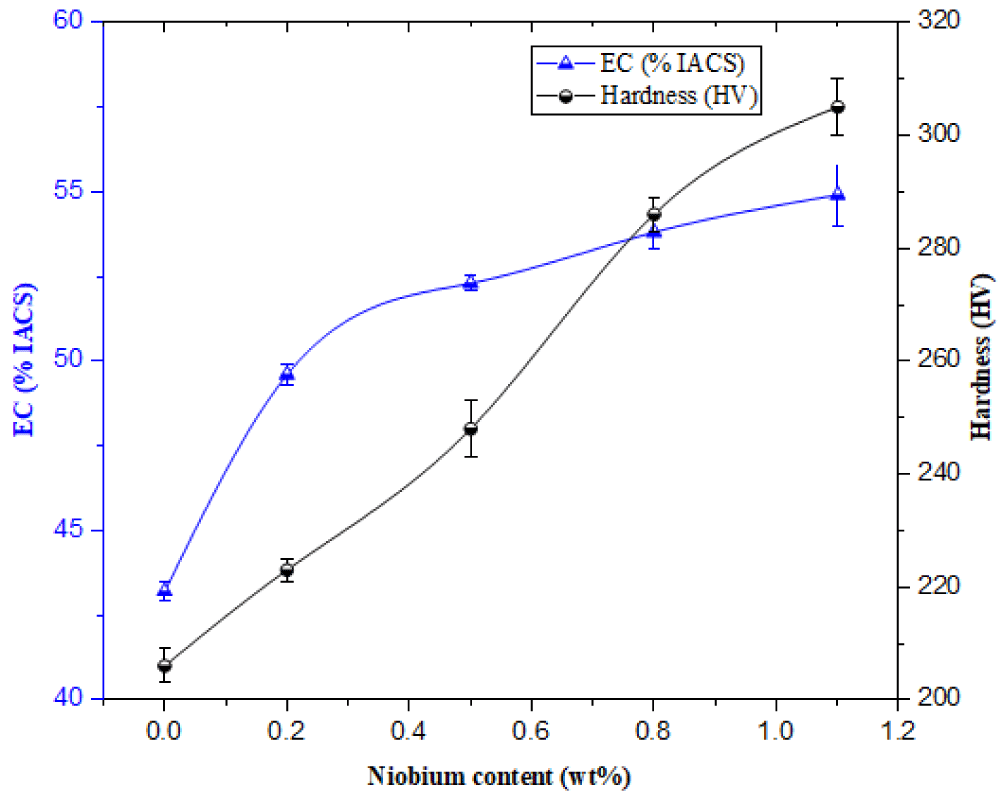Global Journal of Biotechnology and Biomaterial Science
Stress-Strain Characteristics and Electrical Conductivity of Niobium Nanopowder modified Silicon Bronze
Kingsley C Nnakwo1*, Jeremiah L Chukwuneke2, Paul C Okolie2, Chika O Ujah3 and Maxwell C Anukwonke1
2Department of Mechanical Engineering Nnamdi Azikiwe University, Awka, Nigeria
3Department of Mechanical and Industrial Engineering Technology, University of Johannesburg, P.O. Box 524, Johannesburg 2006, South Africa
Cite this as
Nnakwo KC, Chukwuneke JL, Okolie PC, Ujah CO, Anukwonke MC. Stress-Strain Characteristics and Electrical Conductivity of Niobium Nanopowder modified Silicon Bronze. Glob J Biotechnol Biomater Sci. 2024;10(1): 011-015. Available from: 10.17352/gjbbs.000022Copyright Licence
© 2024 Nnakwo KC, et al. This is an open-access article distributed under the terms of the Creative Commons Attribution License, which permits unrestricted use, distribution, and reproduction in any medium, provided the original author and source are credited.Understanding the response of materials to various loads is crucial for fabricating resilient components capable of withstanding anticipated stresses. This experimental study addresses the limited information on the tensile behavior of silicon bronze by investigating the stress-strain characteristics of Cu-4wt%Si alloys modified with niobium nanopowder. The surface morphology of the fabricated alloys was analyzed using a Scanning Electron Microscope (SEM). SEM analysis of the Cu-4wt%Si alloy revealed columnar grains sparsely distributed in the copper matrix, contributing to low strain-to-fracture behavior. Doping the alloy with niobium nanopowder resulted in notable grain modification, increased grain boundary density, and improved grain distribution, correlating with higher strain-to-fracture values. Notably, the Cu-4wt%Si-1.1wt%Nb alloy exhibited significant changes in percentage elongation, ultimate tensile strength, yield strength, fracture strength, and tensile toughness. Furthermore, niobium nanopowder additions increase the hardness and electrical conductivity values, peaking at 305 HV and 54.9 %IACS with 1.1 wt% Nb.
Introduction
The stress-strain characteristics of materials remain crucial in the design of engineering materials for various applications. They offer valuable insights into materials’ response to diverse loads, aiding engineers and researchers in crafting robust components capable of withstanding anticipated stresses. Adequate understanding of stress-strain behavior facilitates material selection, prediction of failure points, and the optimization of materials designs for enhanced efficiency and durability across various applications. Copper-based alloys are known for their high strength, superelectrical conductivity, hardness, ductility, and malleability [1-8]. Based on these unique properties, they are found suitable for electrical connectors, fasteners, conduits, valve stems, lead frames, bolts, and electronic signals [9-16]. Silicon bronze refers to copper alloy with a silicon content ranging from 2% to 4wt% [12-14]. It is known for its excellent corrosion and wear resistance, high-temperature stability, weldability, hardness, and aesthetic appeal, hence considered a material for fasteners, bolts, propellers, shafts, claddings, and sculptures [17-20].
Earlier studies have reported the detrimental effect of the dendritic structure of silicon bronze on its mechanical properties and electrical conductivity [21-24]. These anomalies limit the advanced applications of the material in industries where a combination of hardness and strength is paramount. Out recent studies demonstrated the excellent properties of silicon bronze (Cu-3Si) via alloying and cooling techniques [25-27]. From the studies, the modified dendritic grains enhanced the percentage elongation, strength, and hardness [28-33].
Tavolzhanskii, et al. [28] obtained twin grains in Cu-Si-Mn silicon bronze via drawing and adequate annealing treatment. Filippov, et al. [29] developed recrystallized grains with high-angle boundaries in Cu-Si-Mn silicon bronze via pre-deformation and annealing treatment, improving the UTS and strain-to-fracture. Asaolu, et al. [32] achieved a grain modification in Cu-Si alloy through alloying with nickel and pre-deformation. Aravind, et al. [33] developed a silicon bronze with improved surface hardness, corrosion, and wear resistance via modification of grain by gas tungsten arc. Well-known high-strength copper alloys include Cu-Ni-Si [36,37], Cu-Ti-Cr [38], Cu-Cr-Nb [39], Cu-Co-Si [40], and Cu-Fe-Cr [41]. Nb enhances the mechanical and electrical properties of these alloys by promoting phase precipitation and stabilization [39].
However, mechanical and electrical properties and stress-strain characteristics of Cu-Si-Nb alloys remain unclear. Therefore, this study aimed to develop a novel Cu-4Si-xNb alloy with improved mechanical and electrical performance by varying the concentrations of niobium nanopowder. Additionally, the study explored the behavior of Cu-Si-Nb alloys at different stress levels and failure points in service.
Experimental procedure
Fabrication and testing of Cu-4wt%Si and Cu-4wt%Si-xNb alloys
The study utilized high-purity materials, including 99.99% pure copper rods, 99.5% pure silicon powder, and 99.9% pure niobium nanopowder. The Cu-4wt%Si and Cu-4wt%Si-Nb alloys were fabricated and machined to the appropriate standards for the mechanical and electrical properties tests. The tensile strength, hardness, and electrical conductivity measurements followed established procedures as reported in our previous research works [1,34]. Surface morphology was analyzed using a Carl Zeiss scanning electron microscope (EVO/NA10). Sample preparation involved thorough grinding, polishing, and etching in a solution of iron III chloride, HCl, and water for 30 seconds before analysis.
Results and discussions
Microstructures of niobium nanopowder-modified silicon bronze
Figure 1 depicts the TEM image of the as-received niobium nanopowder (99.9% purity) detailed by Ujah, et al. [35]. The image reveals clustered nanoparticles. Additionally, the particle size distribution is presented in Figure 1b. The particle size distribution, analyzed using ImageJ, provided additional insights into the nanoscale characteristics of the niobium nanopowder.SEM microstructure of the Cu-4wt%Si presented in Figure 2 reveals columnar grains sparsely distributed in the copper matrix. This particular grain morphology may explain the observed low strain-to-fracture behavior at different loads, as demonstrated in Figure 3. SEM images of Cu-4wt%Si doped with various concentrations of niobium nanopowder depict modified grain morphology, with the modification becoming more pronounced with increasing niobium nanopowder concentrations (Figure 2c-e). The SEM of Cu-4wt%Si-1.1wt%Nb alloy reveals substantial grain modification, increased grain count, and improved distribution. These correlate with a higher strain-to-fracture value, as depicted in Figure 3. This comprehensive analysis sheds light on the morphological changes induced by niobium nanopowder doping, providing valuable insights into the alloy’s microstructural evolution and its potential impact on mechanical properties.
Stress-strain behavior and electrical conductivity of niobium nanopowder-modified silicon bronze
Figure 3 illustrates the stress-strain behavior of Cu-4wt%Si and Cu-4wt%Si-xwt%Nb alloys under various loads. The curves provide a detailed insight into how the developed alloys respond to different stresses. Table 1 represents the stress-strain components of the alloys. The Cu-4wt%Si exhibits a notably low stress-to-fracture value, indicating poor ductility. The percentage elongation, ultimate tensile strength, yield strength, fracture strength, and tensile toughness reached 7.3%, 55 MPa, 26 MPa, 6.10 MPa, and 61.1 J/m3, respectively. Cu-4wt%Si alloy doped with various concentrations of niobium nanopowder demonstrates improved strain-to-fracture behavior. The strain-to-fracture value increases with higher niobium nanopowder concentrations, with Cu-4wt%Si-1.1wt%Nb alloy exhibiting significant enhancements. This alloy records percentage elongation, ultimate tensile strength, yield strength, fracture strength, and tensile toughness values of 54.7%, 274 MPa, 205 MPa, 171 MPa, and 22,500.4 J/m3, respectively. These improvements can be attributed to the intense modification of grain structure induced by the addition of niobium nanopowder, (Figure 2). Figure 4 presents the hardness and electrical conductivity (EC) values of Cu-4wt%Si and Cu-4wt%Si-wt%Nb alloys. Cu-4wt%Si alloy exhibited hardness and EC values of 206 HV and 43.2% IACS. After incorporating niobium nanopowder, the hardness and electrical conductivity were increased by 8.3% and 14.8%, respectively. The hardness and EC values showed increasing trends with niobium nanopowder additions, reaching 305 HV and 54.9% IACS, respectively, resulting from grain modification and increased precipitation of intermetallic compounds. Cu-Si-Nb alloys could serve in components of biomedical devices that require reliable electrical conductivity and mechanical strength, such as pacemakers or other implanted electronic devices.
Future directions
Future research should focus on additive manufacturing and optimize metallurgical processes to develop Cu-Si-Nb alloys with unique mechanical and electrical properties. Additionally, the alloy’s suitability for biomedical applications, such as surgical instruments, dental tools, and bioelectronic devices, should be investigated, leveraging its strength, durability, and conductivity.
Conclusion
The study on niobium nanopowder-modified silicon bronze revealed significant improvements in the microstructure and properties of Cu-4wt%Si alloys. The addition of niobium nanopowder notably altered the grain morphology, leading to high strain-to-fracture values. The niobium-doped Cu-4wt%Si alloy demonstrated improved elongation at break, tensile strength, yield strength, fracture strength, and tensile toughness. The hardness and electrical conductivity reached maximum values of 305 HV and 54.9% IACS, respectively. These findings offer valuable insights for the development and application of advanced materials.
- Nnakwo KC. Effect of tungsten content on the structure, physical and mechanical properties of silicon bronze (Cu-3wt%Si). J King Saud Univ - Sci. 2019;31(4):844-848. Available from: https://doi.org/10.1016/j.jksus.2017.12.002
- Nnakwo KC, Mbah CN, Daniel-Mkpume CC. Investigation of the structural sensitive behavior of Cu-3Si-xMn ternary alloys. J King Saud Univ - Sci. 2019;31(4):1056-1063. Available from: https://doi.org/10.1016/j.jksus.2019.01.001
- Nnakwo KC, Mbah CN, Nnuka EE. Influence of trace additions of titanium on grain characteristics, conductivity and mechanical properties of copper-silicon-titanium alloys. Heliyon. 2019;5(10). Available from: https://doi.org/10.1016/j.heliyon.2019.e02471
- Nnakwo KC, Mbah CN, Ude SN. Influence of chemical composition on the conductivity and some mechanical properties of Mg-doped Cu-Si alloy. J King Saud Univ - Eng Sci. 2020;32(5):287-292. Available from: https://doi.org/10.1016/j.jksues.2019.03.005
- Nnakwo KC, Osakwe FO, Ugwuanyi BC, Oghenekowho PA, Okeke IU, Maduka EA. Grain characteristics, electrical conductivity, and hardness of Zn-doped Cu–3Si alloys system. SN Appl Sci. 2021;3(11):829. Available from: https://link.springer.com/article/10.1007/s42452-021-04784-1
- Gholami M, Vasely J, Altenberger I, Kuhn HA, Wollmann M, Janecek M, et al. Influence of grain size and precipitation hardening on high cycle fatigue performance of CuNiSi alloys. Mater Sci Eng A. 2017;684:524-533. Available from: https://doi.org/10.1016/j.msea.2016.12.082
- Gholami M, Vasely J, Altenberger I, Kuhn HA, Wollmann M, Janecek M, et al. Effect of microstructure on mechanical properties of CuNiSi alloys. J Alloys Compd. 2017;696:201-212. Available from: https://doi.org/10.1016/j.jallcom.2016.11.233
- Nnakwo KC, Okeke IU, Nnuka EE. Structural modification and mechanical properties of Cu-3wt%Si-xwt%Sn alloy. Int J Sci Res Sci Eng Technol. 2017;3:184-187. Available from: https://www.researchgate.net/publication/327582004_Structural_Modification_and_Mechanical_Properties_of_Cu-3wtSi-xwtSn_Alloy
- Nnakwo KC, Okeke IU, Nnuka EE. Effect of zinc content on the structure and mechanical properties of silicon bronze. Int J Sci Res Sci Eng Technol. 2017;3:179-83. Available from: https://www.researchgate.net/profile/Kingsley-Nnakwo/publication/327582220_Effect_of_Zinc_Content_on_the_Structure_and_Mechanical_Properties_of_Silicon_Bronze/links/5b981a3f299bf14ad4cea1d5/Effect-of-Zinc-Content-on-the-Structure-and-Mechanical-Properties-of-Silicon-Bronze.pdf
- Lei Q, Xiao Z, Hu W, Derby B, Li Z. Phase transformation behaviors and properties of a high strength Cu-Ni-Si alloy. Mater Sci Eng A. 2017;697:37-47. Available from: https://doi.org/10.1016/j.msea.2017.05.001
- Li D, Wang Q, Jiang B, Li X, Zhou W, Dong C, et al. Minor-alloyed Cu-Ni-Si alloys with high hardness and electric conductivity designed by a cluster formula approach. Prog Nat Sci Mater Int. 2017;27:467-473. Available from: https://doi.org/10.1016/j.pnsc.2017.06.006
- Nnakwo KC, Nnuka EE. Correlation of the structure, mechanical and physical properties of Cu-3wt%Si-xwt%Sn silicon bronze. J Eng Appl Sci. 2018;13:83-91.
- Nnakwo KC, Odo JU, Eweka KO, Okafor JS, Ijomah AI, Maduka EA, et al. Evaluation of the electrical conductivity and mechanical properties of Cu–3Ti–1.5Ni–0.5Si quaternary alloy. JOM. 2022;74(5):4174-4180. Available from: https://link.springer.com/article/10.1007/s11837-022-05293-1
- Nwankwo NE, Ijomah AI, Nnakwo KC, Okeke IU. Grain refinement, impact energy, and physiomechanical properties of Cu-3Si-3W and Cu-3Si-3Mn alloys via alloying and solid solution treatment. J Emerg Technol Innov Res. 2023;10(9):583-589. Available from: https://www.jetir.org/papers/JETIR2309264.pdf
- Qian L, Zhou L, Zhou L, Yang G, Xi P, Benjamin D. Microstructure and mechanical properties of a high strength Cu-Ni-Si alloy treated by combined aging processes. J Alloys Compd. 2017;695:2413-2423. Available from: https://doi.org/10.1016/j.jallcom.2016.11.137
- Wang W, Kang H, Chen Z, Chen Z, Li R, Yin G, et al. Effects of Cr and Zr addition on microstructure and properties of Cu-Ni-Si alloys. Mater Sci Eng A. 2016;673:378-390. Available from: https://doi.org/10.1016/j.msea.2016.07.021
- Ijomah AI, Nnakwo KC, Nnuka EE, Okeke IU. Enhancing the structure and mechanical properties of Cu-3Si-Al ternary alloy by addition of aluminium. Int J Novel Res Eng Sci. 2023;10(2):7-11. Available from: https://doi.org/10.5281/zenodo.8344418
- Ijomah AI, Nnakwo KC, Odo JU, Okeke IU. Microstructure, impact energy, density, and electrical properties of Cu-3Si alloy system doped with molybdenum. Int J Novel Res Eng Sci. 2023;10(2):1-6. Available from: http://dx.doi.org/10.5281/zenodo.8344286
- Ijomah AI, Nnakwo KC, Okeke IU, Odo JU. Tailoring the surface morphology of Al, Mo-doped copper-silicon alloys for enhanced impact resistance. Int J Novel Res Electr Mech Eng. 2023;11(1):1-6. Available from: https://doi.org/10.5281/zenodo.8344705
- Ijomah AI, Nnakwo KC, Nwankwo NE, Ugwuanyi BC. Solid solution-induced ultrafine Cu-3Si-Al and Cu-3Si-Mo ternary alloy. Int J Eng Res Rev. 2023;11(3):59-63. Available from: http://dx.doi.org/10.5281/zenodo.8348425
- Ijomah AI, Nnakwo KC, Nwankwo NE, Okeke IU. Synergistic effects of alloying elements and solid solution treatment on the impact energy, density and conductivity of Cu-3Si-3(Zn, Sn) alloys system. Int J Civil Struct Eng Res. 2023;11(1):85-90. Available from: https://doi.org/10.5281/zenodo.8348613
- Ijomah AI, Nnakwo KC, Odo JU, Okeke IU. Microstructure, impact and electrical behavior of fine grained Cu-Si-(Mg, Ti) alloy after solid solution strengthening. J Emerg Technol Innov Res. 2023;10(9):590-597. Available from: https://www.researchgate.net/publication/373953700_Microstructure_impact_and_electrical_behavior_of_fine_grained_Cu-Si-Mg_Ti_alloy_after_solid_solution_strengthening
- Ijomah AI, Nnakwo KC, Nwankwo NE, Okeke IU. Evaluation of solid solution strengthening of copper-silicon binary alloys by carbide forming elements. Int J Mech Ind Technol. 2023;11(1):48-53. Available from: http://dx.doi.org/10.5281/zenodo.8348120
- Ijomah AI, Nnakwo KC, Odo JU, Okeke IU. Improving the structure, tensile strength and hardness of molybdenum-doped copper-silicon alloy system. Int J Mech Ind Technol. 2023;11(1):54-59. Available from: http://dx.doi.org/10.5281/zenodo.8348223
- Ijomah AI, Nnakwo KC, Nwankwo Odo JU, Okeke IU. Experimental study of microstructure, impact energy, physical, and electrical properties of Al-doped Cu-3Si-Al ternary alloy. Int J Civil Struct Eng Res. 2023;11(1):79-84. Available from: http://dx.doi.org/10.5281/zenodo.8348557
- Nwankwo NE, Nnakwo KC, Ijomah AI, Okeke IU. Influence of homogenization heat treatment on grain characteristics and mechanical properties of copper-silicon-zinc and copper-silicon-tin ternary alloys. Int J Eng Res Rev. 2023;11(1):64-69. Available from: http://dx.doi.org/10.5281/zenodo.8348507
- Ijomah AI, Nnakwo KC, Nnuka EE, Okeke IU. Grain characteristics, tensile strength and hardness of solid solution heat treated copper-silicon-titanium and copper-silicon-magnesium alloys. Int J Novel Res Electr Mech Eng. 2023;11(1):7-13. Available from: https://doi.org/10.5281/zenodo.8344842
- Tavolzhanskii SA, Vedenkin ED, Plisetskaya IV, Bazhenov VE, Nikitina AA. Study of properties and structure of silicon bronze CuSi3Mn1 (C65500) wire at various stages of its production by continuous casting and subsequent drawing. Metallurgist. 2022;66(7–8):962-969.. Available from: https://link.springer.com/article/10.1007/s11015-022-01408-w
- Filippov A, Shamarin N, Moskvichev E, Savchenko N, Kolubaev E, Khoroshko E, et al. The effect of heat input, annealing, and deformation treatment on structure and mechanical properties of electron beam additive manufactured (EBAM) silicon bronze. Materials. 2022;15(9):3209. Available from: https://doi.org/10.3390/ma15093209
- Gangwar S, Pathak VK. Preliminary evaluations on development and material selection of high temperature vacuum casted marble dust-reinforced silicon-bronze alloy material for bearing applications. Proc Inst Mech Eng Part L J Mater Des Appl. 2021;235(1):131-148. Available from: https://www.doi.org/10.1177/1464420720953447
- Filippov A, Khoroshko E, Shamarin N, Kolubaev E, Tarasov S. Study of the properties of silicon bronze-based alloys printed using electron beam additive manufacturing technology. Obrabotka Metallov. 2023;25(1):110-30. Available from: https://cyberleninka.ru/article/n/issledovanie-svoystv-splavov-na-osnove-kremnievoy-bronzy-napechatannyh-s-primeneniem-tehnologii-elektronno-luchevogo-additivnogo
- Asaolu AO, Omotoyinbo JA, Oke SR, Falodun OE, Olubambi PA. Effect of nickel addition on microstructure, tensile and corrosion properties of cold rolled silicon bronze. Mater Today Proc. 2021;38:1147-1151. Available from: http://dx.doi.org/10.1016/j.matpr.2020.07.136
- Aravind A, Saravanan R. Improvement in hardness, wear rate and corrosion resistance of silicon bronze using gas tungsten arc. Mater Today Proc. 2020;24:406-414. Available from: https://doi.org/10.1016/j.matpr.2020.04.292.
- Nnakwo KC, Amadi FE, Aigbodion VS, Ezeanyanwu JN, Nwogbu CC, Agbo AO, et al. Improving the thermo-physical behavior of Li2O-Al2O3-P2O5-SiO2 glass–ceramic system by triple-step heat treatment processes. Int J Adv Manuf Technol. 2023;129:3447-3452. Available from: https://link.springer.com/article/10.1007/s00170-023-12547-y
- Ujah CO, Popoola P, Popoola O, Aigbodion VS, Oladijo P. Improving tribological and thermal properties of Al alloy using CNTs and Nb nanopowder via SPS for power transmission conductor. Trans Nonferrous Met Soc China. 2020;30:333-343. Available from: http://dx.doi.org/10.1016/S1003-6326(20)65216-5
- Yang YH, Li SY, Cui ZS, Li Z, Li YP, Lei Q. Microstructure and properties of high-strength Cu–Ni–Si–(Ti) alloys. Rare Metals. 2021;40(11):3251-3260. Available from: http://dx.doi.org/10.1007/s12598-020-01699-5
- Wu Y, Li Y, Lu J, Tan S, Jiang F, Sun J. Effects of pre-deformation on precipitation behaviors and properties in Cu-Ni-Si-Cr alloy. Mater Sci Eng A. 2019;742:501-507. Available from: https://doi.org/10.1016/j.msea.2018.11.045
- Wang X, Xiao Z, Qiu WT, Li Z, Liu F. The evolution of microstructure and properties of a Cu–Ti–Cr–Mg–Si alloy with high strength during the multi-stage thermomechanical treatment. Mater Sci Eng A. 2021;803:140730. Available from: https://doi.org/10.1016/j.msea.2020.140510
- Guo X, Xiao Z, Qiu W, Li Z, Zhao Z, Wang X, et al. Microstructure and properties of Cu-Cr-Nb alloy with high strength, high electrical conductivity and good softening resistance performance at elevated temperature. Mater Sci Eng A. 2019;749:281-290. Available from: https://doi.org/10.1016/j.msea.2019.02.036
- Geng Y, Li X, Zhou H, Zhang Y, Jia Y, Tian B, et al. Effect of Ti addition on microstructure evolution and precipitation in Cu–Co–Si alloy during hot deformation. J Alloys Compd. 2020;821:153518. Available from: https://doi.org/10.1016/j.jallcom.2019.153518
- Yuan D, Xiao X, Chen J, Han B, Huang H, Yang B. Influence of Ag addition on the microstructure and properties of Cu-6.5Fe-0.2Cr alloy prepared by upward continuous casting. J Alloys Compd. 2021;887:161458. Available from: https://doi.org/10.1016/j.jallcom.2021.161458

Article Alerts
Subscribe to our articles alerts and stay tuned.
 This work is licensed under a Creative Commons Attribution 4.0 International License.
This work is licensed under a Creative Commons Attribution 4.0 International License.





 Save to Mendeley
Save to Mendeley
